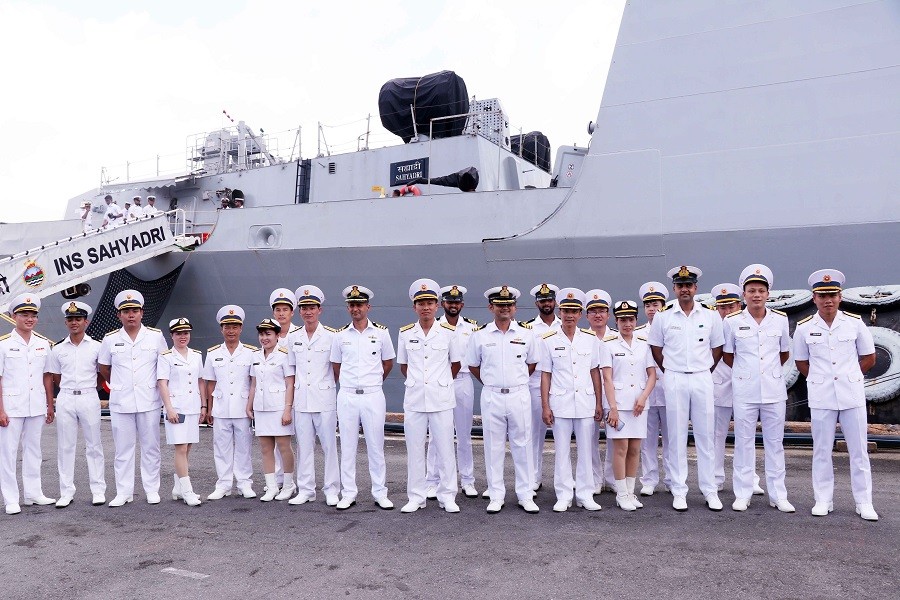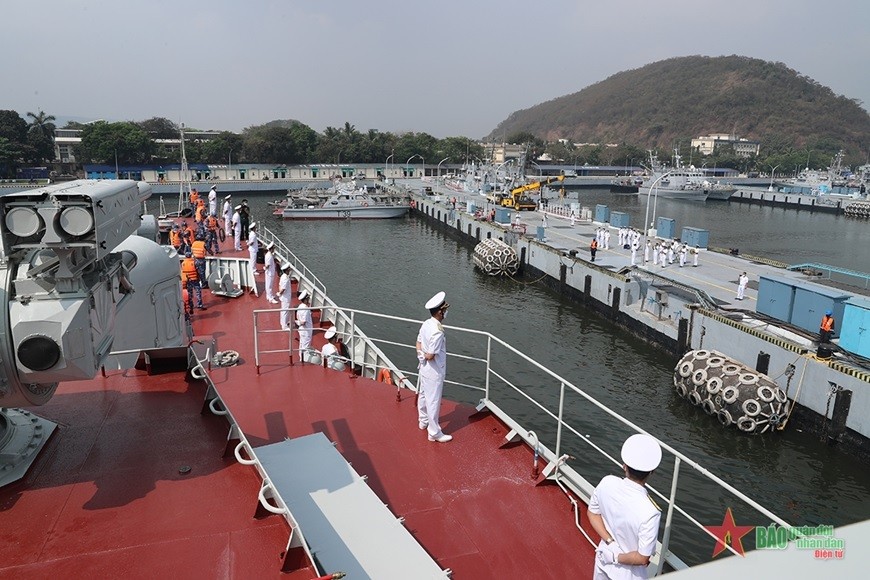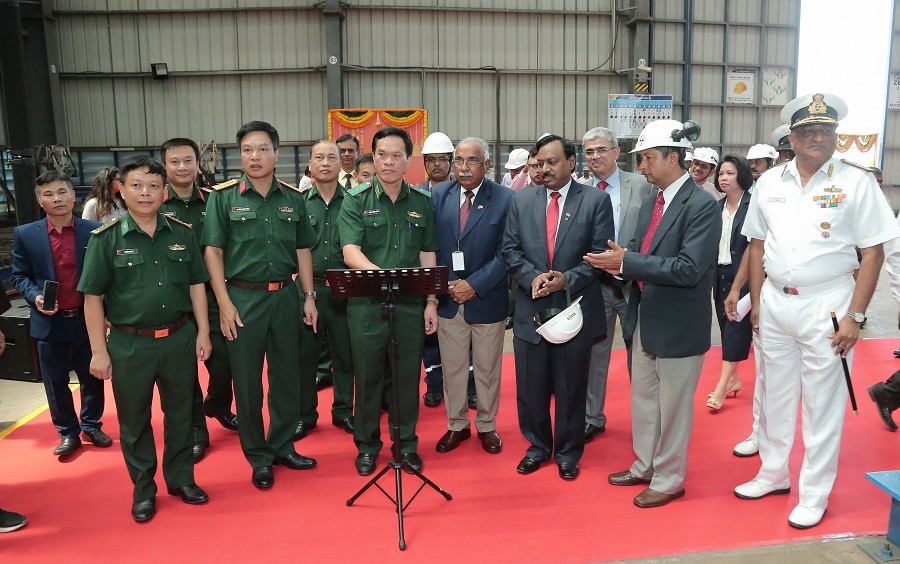
Maritime cooperation in South China Sea spearheads Viet Nam - India strategic cooperation
Latest
 |
| Two Indian Naval Ships, INS SAHYADRI and INS KADMATT under the Flag Officer Commanding Eastern Fleet, Rear Admiral Sanjay Bhalla, NM makes a port call at Ho Chi Minh City Port from June 24-26, 2022. (Photo: VNA) |
Viet Nam and India have had long-lasting connection for thousands of years through trade and missionary activities from India to the Indochinese peninsula and vice versa. Since 2016, the two countries have upgraded their relationship to a Comprehensive Strategic Partnership, making India one of only three countries with the highest and most comprehensive bilateral relationship with Viet Nam. Having long coastlines, Viet Nam and India feel the urge for international maritime cooperation to make their surrounding seas a space for cooperation, development and protection of national security. Since pursuing the Look East Policy of 1991 and Act East Policy of 2014, India has considered Viet Nam a main pillar in its relationship with Southeast Asia. In turn, maritime cooperation in the South China Sea is a strategic spearhead for bilateral relations.
Shared interests
Among the first countries to advance the idea of a large Indo-Pacific region, India recognized the importance of the South China Sea as a connecting route and its strategic position in safeguarding of regional peace, stability and prosperity.
India has, in the recent years, gradually adjusted its position towards the South China Sea to show its growing concerns and has expressed the interest to play a greater role in the region. While retaining neutrality in territorial and maritime disputes among regional claimants, recently, New Delhi has actively declared its stance based on international laws. At the 17th Shangri La Dialogue in 2018, Indian Prime Minister Narendra Modi stated that India upheld the principles of international law that countries should have equal access to common waters and airspaces, unimpeded freedom of navigation should be maintained, and countries must settle disputes by peaceful means in accordance with international law. In May 2020 Indian Foreign Ministry spokesman Anurag Srivastava further clarified that the South China Sea was part of the global common sea and India had an interest in maintaining peace and stability in the region. It remains firm in defending maritime and aviation freedom and unimpeded trade routes through the South China Sea in accordance with international law.
India’s greater involvement in the South China Sea also reflects its economic interests in the region, including protecting the freedom of navigation of commercial vessels traversing through the South China Sea and its right to conduct joint exploitation of natural resources with regional partners. In the 2020-2021 fiscal year, India’s two-way trade with ASEAN countries stood at nearly US$ 80 billion. With Northeast Asian countries it was US$ 150 billion, accounting for nearly one-third of the total value of India’s mercantile trade. Statistics from the US Center for Strategic and International Studies (CSIS) show that in 2016, nearly 31% of India’s total mercantile trade value passed through the South China Sea. Another study by India’s Observer Research Fund (ORF) estimated that about US$ 200 billion, or 55% of India’s total trade with the Indo-Pacific region passes through this maritime zone.
Trade agreements with countries and organizations in the region such as with Singapore (2005), Malaysia (2011), Japan (2011), the Republic of Korea (2009), ASEAN (2009, 2015) and the Act East policy under Prime Minister Modi are the foundation for India’s trade relations with East Asia to further develop. This means India has an important interest ensuring security and freedom of navigation in the South China Sea.
In addition, the South China Sea is rich in natural resources, with abundance of oil and gas resources. Most of the resources are located in the exclusive economic zones of countries along the South China Sea and have not yet been exploited. With its huge population, India depends heavily on external energy sources. In 2020, oil imports accounted for 85% of the country’s total oil and gas needs. Access to oil and gas resources in the South China Sea contributes to ensuring India’s energy security and less dependence on a few partners. New Delhi, therefore, encourages countries in the region to develop a code of conduct to manage disputes, ensure free trade and allow countries outside the region to have access to natural resources.
From Ha Noi’s perspective, the South China Sea has a sacred meaning in terms of sovereignty. It has a geostrategic position to ensure Viet Nam’s security and is particularly important for the country’s development path. Viet Nam’s Sustainable Maritime Economic Development Strategy towards 2030, with a vision towards 2045, identifies the marine economy as an engine of its economic growth in the coming period. At the same time, Ha Noi’s key task is to resolutely and persistently fight to protect the sovereignty, unity and territorial integrity in the South China Sea in the context of regional complexity. Ha Noi, thereby supports peaceful settlement of maritime disputes in accordance with international law.
 |
| Viet Nam’s Frigate 016 - Quang Trung attends the multilateral naval exercise MILAN 2022 which took place in the northern India city of Visakhapatnam from February 25 to March 4. |
Comprehensive cooperation
New Delhi sees Ha Noi as a pillar of its Act East policy. Indian Prime Minister Modi has repeatedly named Viet Nam India’s key linchpin in its relations with Southeast Asia. Meanwhile, Ha Noi seeks to diversify relations with other countries to protect sovereignty, enhance security and promote development in the South China Sea. India combines the conditions of becoming a key and comprehensive partner in many fields. This forms the foundation for promoting comprehensive Viet Nam - India cooperation in the South China Sea.
Recent joint statements by both countries have demonstrated their growing shared vision on maritime security and cooperation. The two countries’ fundamental maritime position was shaped in a Joint Statement during the State Visit by Vietnam Communist Party’s General Secretary Nguyen Phu Trong to India in 2013, which reaffirmed the need to ensure freedom of navigation in the South China Sea and called for relevant parties to restrain from threats or use of force, to settle disputes through peaceful means in accordance with principles of universally recognized international law stated in the UN Convention on the Law of the Sea (UNCLOS). The Joint Statement also urged relevant parties to commit in implementing the Declaration on the Conduct of Parties in the South China Sea (DOC) established in 2002 and supported an early approval of the Code of Conduct in the South China Sea (COC) on the consensus basis. It called for cooperation to ensure the security of sea routes, anti-piracy enforcement, and cooperation in search and rescue at sea. It welcomed the regular conduct of bilateral defense dialogues, training, drills, as well as passage of naval ships and coast guard visits. In addition, Viet Nam and India welcomed the Memorandum of Understanding on training Vietnamese naval and air force officers and the signing of the Agreement on Logistics. The Vietnamese side prioritizes India for new oil and gas exploration, production opportunities as well as welcomes new investment projects by Indian companies in oil and gas projects in Viet Nam.
Another outstanding demonstration of Viet Nam - India political commitment in promoting maritime cooperation in the South China Sea is The Viet Nam - India Joint Vision Statement on Peace, Prosperity and People in December 2020. This document affirms that the COC negotiation must be substantive and effective, without affecting the legitimate rights and interests of all countries in the South China Sea, including countries not participating in the negotiations. The two sides also highlighted the importance of finding new and substantive areas of cooperation to enhance maritime economic capacity, maritime security and safety, environmentally sustainable use of marine resources, as well as maritime connectivity, in order to ensure security and growth for the whole region.
 |
| India’s Larsen & Toubro Kattupalli shipyard near Chennai city of Tamil Nadu state launches a project to build 12 high-speed patrol boats for the Vietnam Border Guard Force, funded by the Indian government’s credit package on August 14, 2019. (Photo: VNA) |
In operational level, defense and security takes the lead in Viet Nam – India cooperation in the South China Sea. In 2014, India provided a defense credit package worth US$ 100 million to help Viet Nam build 12 high-speed patrol boats, of which 5 were built in India and 7 were built in Viet Nam. All 12 of these ships have all been commissioned for Viet Nam’s maritime border guards. India also supports training to operate ships for the submarine force of the Vietnamese navy. Since 2018, the two countries have developed a periodic maritime security dialogue mechanism at the Directorate level. Modern warships of India regularly visit and conduct bilateral naval training with the Vietnamese navy in the South China Sea. In addition, Viet Nam – India cooperation in air force and land-based defense systems also plays an important role in strengthening Viet Nam’s defense of the South China Sea.
In the field of maritime economic development, Ha Noi and New Delhi focus on cooperation in oil and gas exploration and production. Since the late 1980s, the Indian National Oil and Gas Group (ONGC Videsh) has become an important oil and gas exploration partner of the Viet Nam National Oil and Gas Group (PetroVietnam or PVN) in the South China Sea. This partnership has successfully discovered, explored, and developed the Lan Do and Lan Tay gas fields. Bilateral cooperation between Viet Nam and India in this field has been maintained and expanded through many bilateral agreements between the two governments as well as the two national oil corporations over the past 10 years.
Viet Nam - India maritime cooperation is also promoted in multilateral frameworks. The two sides have coordinated to promote the ASEAN – India Strategic Dialogue on maritime cooperation and agreed to actively support each other and coordinate their activities within multilateral cooperation frameworks, especially ARF and ADMM+. In 2022 Vietnamese warships participated in the Milan 2022 multilateral military training hosted by India. In the economic field, since 2018, Viet Nam and India have initiated models of cooperation with a third party in oil and gas exploitation projects in the South China Sea.
***
Viet Nam – India cooperation in the South China Sea is a strategic spearhead in their bilateral relationship, which is increasingly consolidated, and stems from shared geostrategic, security and economic interests between the two countries. It is a substantive relationship based on trust and traditional friendship, utilizing the strengths of each side and affirming the roles of India and Viet Nam in their active participation in a defining regional order. Additionally, the two countries have great potentials for cooperation in other areas, such as aquaculture technology, seafood processing and import/export, and increasing connectivity between seaports of the two countries as well as with other countries in the region.









